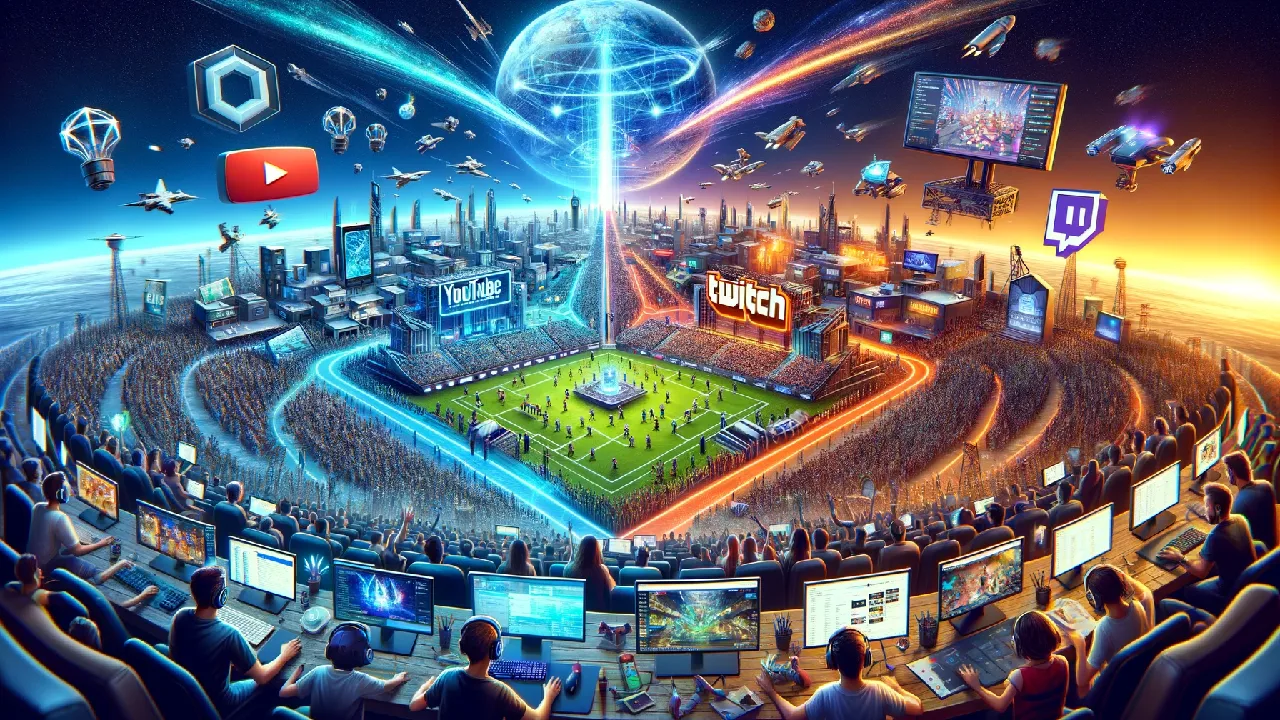Thinking of starting or expanding your career in Streaming, and considering which platform to go for in this ever evolving arena?
Dive deep into the world of streaming as we explore YouTube vs Twitch Streaming.
Uncover features, benefits, and key differences that can guide you in making the best choice for your streaming career.
This article delves into the intricacies of YouTube vs Twitch Streaming, providing a comprehensive guide for you to make the right choice when it comes to streaming.
YouTube vs Twitch Streaming: How to Make the Right Choice?
Streaming platforms have completely changed the way audiences consume content, turning passive viewers into interactive communities. And there is no doubt, that among these streaming platforms, YouTube and Twitch have emerged as titans, each offering unique landscapes for streamers and viewers alike.
As the streaming landscape evolves, there are multiple factors you should keep in mind as you begin your streaming journey. While evaluating YouTube vs Twitch streaming, you should consider the features and benefits of each platform, user interface and experience, audience demographics and preferences, content creation and management, and streaming trends.
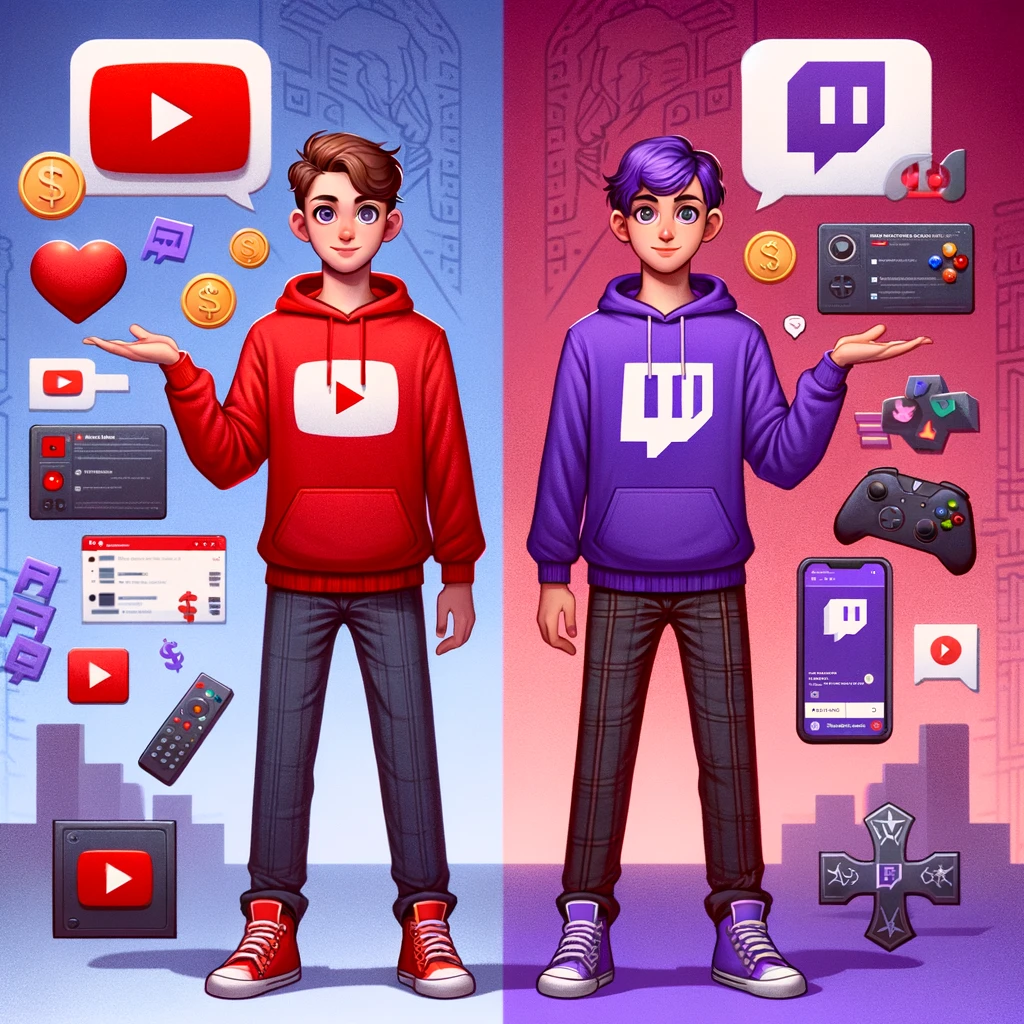
YouTube vs Twitch Streaming: Features and Benefits
The first factor when considering which platform to go for between YouTube and Twitch, would be evaluating their features and benefits, with respect to Streaming Capabilities, Audience Type, Audience Engagement Tools, Monetization Tools, Analytics and Performance Dashboarding, as well as the exclusive benefits each of them offers.
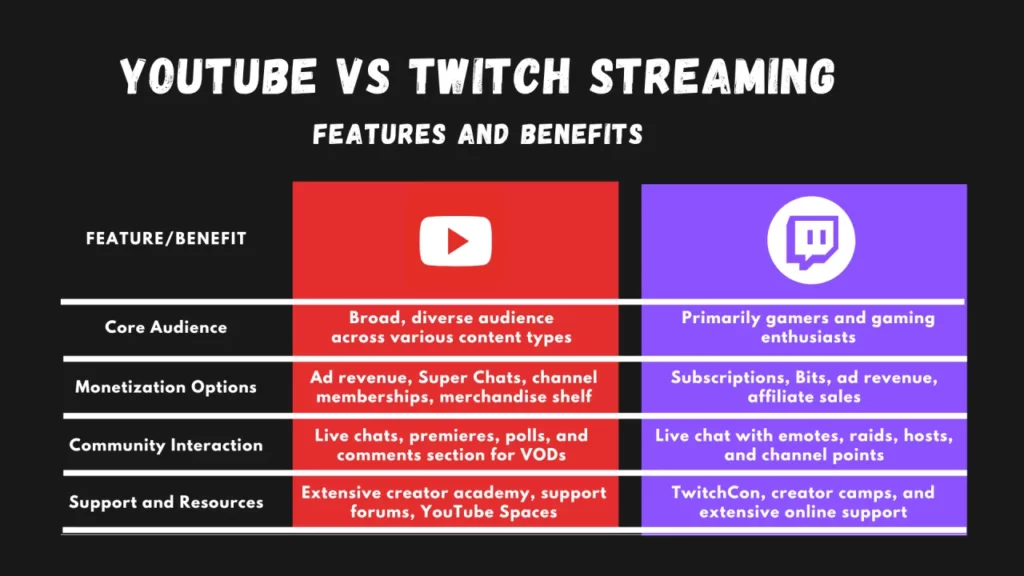
YouTube Streaming: Features and Benefits
YouTube, a behemoth in video content, extends its dominion to live streaming, presenting a versatile platform for creators of all genres.
Its live streaming capability allows for real-time interaction, bringing creators and audiences closer. With a robust monetization model, YouTube offers multiple revenue streams including ads, Super Chats, and channel memberships, making it an attractive platform for creators looking to monetize their content.
Audience engagement on YouTube is bolstered through features like live chats, polls, and premieres, enhancing the communal experience of live streams. Moreover, YouTube’s vast content library promotes flexibility, allowing streamers to diversify their offerings from live streams to vlogs, tutorials, and more.
1. Using YouTube’s Powerful Live Streaming Capabilities: HD Streaming at a Moment’s Notice
YouTube’s live streaming service is designed to be both accessible and powerful, allowing creators to go live at a moment’s notice or schedule streams in advance. This flexibility ensures that content creators can plan their live events to maximize viewer engagement.
YouTube supports high-definition streaming, ensuring that your live content is delivered with crystal-clear quality, enhancing the viewer’s experience.
2. Tapping into YouTube’s Global Reach and Accessibility with Wide Reach and Scale
YouTube’s vast global audience of over 2.5 Billion people means that live streams have the potential to reach viewers from all corners of the world. The platform’s accessibility, available in multiple languages and regions, ensures that content creators can connect with a diverse and widespread audience, breaking geographical barriers.
YouTube also has a vast majority of audience with varied interests, who are just hungry for any form of video content. Having started initially as just a video content platform, it has an edge over Twitch in terms of it’s wide reach and scale, not sticking to any particular niche.
3. Expanding your Streaming Scope with YouTube’s Content Flexibility and Diversity
YouTube’s broad content guidelines allow for a wide range of live streaming content, from live performances and workshops to gaming streams and educational seminars.
This diversity not only caters to a broad audience but also allows creators to experiment with different types of content, expanding their reach and engaging with new viewer segments.
4. Hyper-engagement with your Audience with YouTube Tools: Live Chat, Polls, Q&A
Engaging with the audience is crucial during live streams, and YouTube provides a suite of tools to facilitate this interaction, including Live Chat, Polls and Q&A.
- The live chat feature allows viewers to communicate with the streamer and each other in real-time, creating a sense of community and immediacy.
- Creators can also use features like polls and Q&A sessions to directly involve their audience in the content, making the live stream more interactive and personalized.
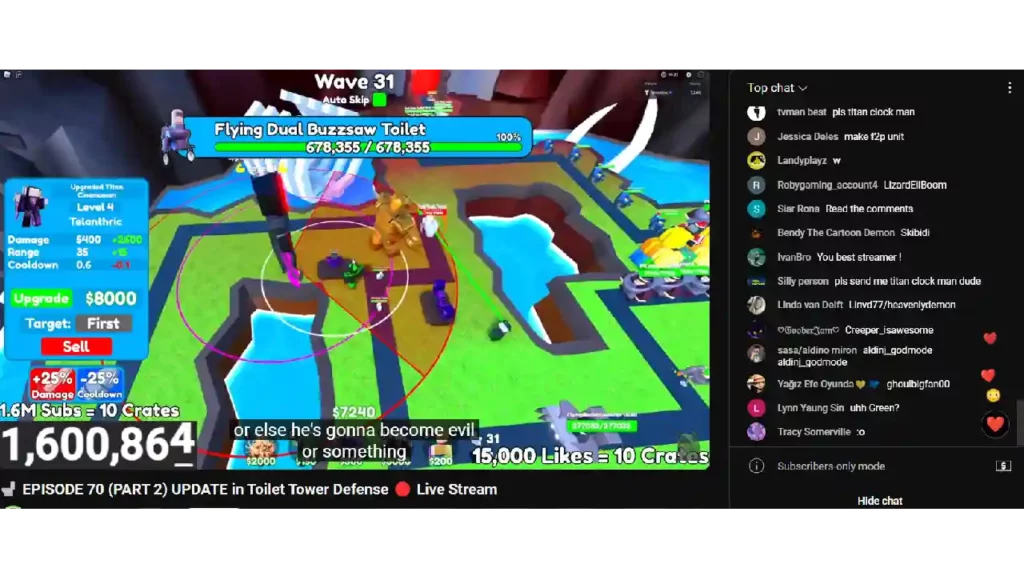
5. Using YouTube Ecosystem for Increasing Your Streaming Reach
Streaming on YouTube means being part of a larger ecosystem that includes VOD (Video On Demand), Shorts, and more. This can help you increase your reach, and drive connectivity within your community through a 24×7 Live Comment section, even when you’re not streaming.
Live streams can be archived and saved on the channel, providing lasting value and continued viewership even after the live event has ended.
Furthermore, YouTube’s algorithm can help in discovering live content, potentially increasing a creator’s visibility and subscriber base.
6. Earning $$$ with YouTube’s Monetization and Revenue Streams: Ad Revenue, Super Chats, Stickers and Memberships
One of the standout features of YouTube Streaming is its monetization capabilities. Creators can benefit from a variety of revenue streams including Ad Revenue, Super Chats and Super Stickers, and Channel Memberships.
- Ad Revenue: Monetized channels can earn revenue from ads displayed before or during their live streams.
- Super Chats and Super Stickers: These features allow viewers to highlight their messages within the live chat by making a purchase, offering a direct way to support their favorite creators.
- Channel Memberships: Creators can offer paid memberships to their viewers, providing exclusive perks such as custom badges, emojis, and access to members-only content.
These monetization options not only provide financial incentives for creators but also enhance the interactivity and exclusivity of the live streaming experience for viewers.
7. Better your Streaming Performance using Advanced Analytics with YouTube Creator Studio Dashboard
YouTube provides detailed analytics for live streams, giving creators insights into viewer behavior, engagement metrics, and performance statistics. This data is invaluable for understanding the audience, refining content strategies, and optimizing future live streams for better performance and engagement.
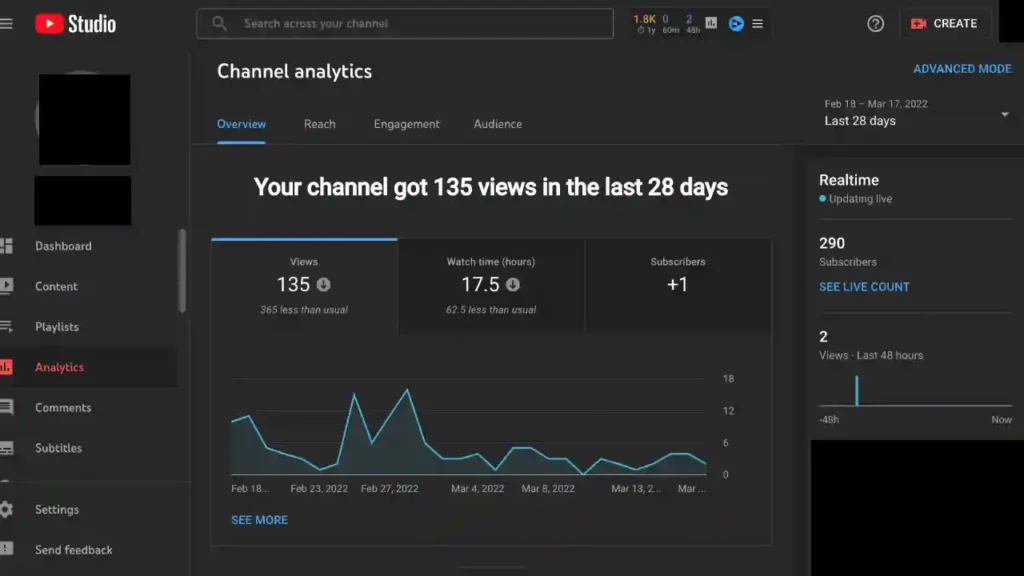
Twitch Streaming: Features and Benefits
Twitch stands as the sanctuary for gaming enthusiasts and live stream aficionados.
It emphasizes community building through interactive chat rooms, emotes, and channel points, creating a vibrant ecosystem for streamers and viewers. Monetization on Twitch is primarily through subscriptions, bits, and donations, offering a direct line of support from viewers to creators.
Exclusive to gaming and creative content, Twitch offers niche appeal but with intense loyalty and engagement. The platform provides extensive support and resources for streamers, including TwitchCon, meetups, and partner programs, fostering a supportive environment for content creators.
1. Go Niche with Twitch Exclusives and Gaming Focus
Twitch is synonymous with gaming, offering unparalleled access to live gaming content, esports events, and gaming communities. The platform also hosts exclusive Twitch Drops and Game Sales in collaboration with Game Developers.
- Twitch Drops: In collaboration with game developers, Twitch offers in-game rewards to viewers who watch streams of specific games, incentivizing engagement.
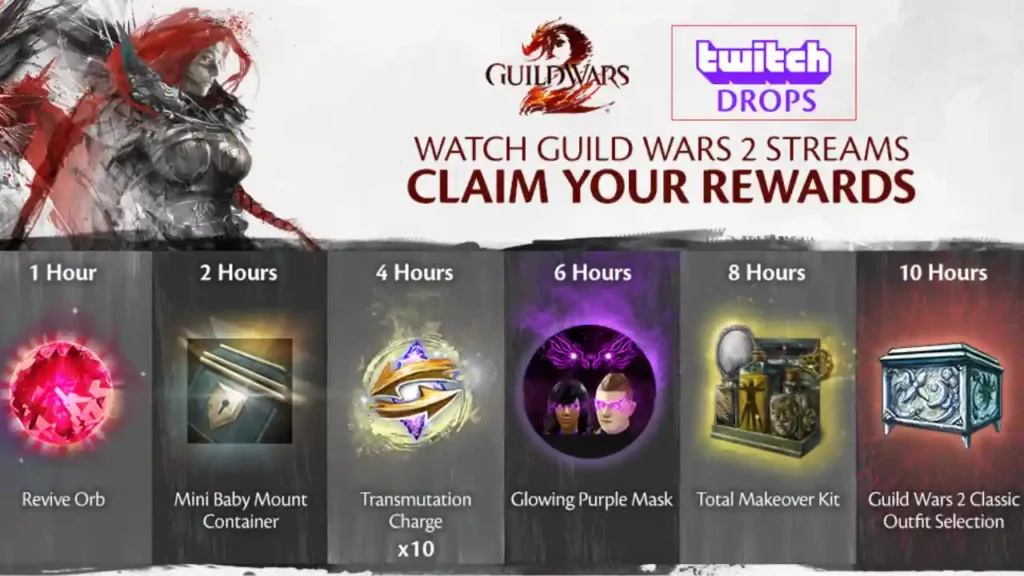
- Game Sales: Streamers can earn commissions by promoting and selling games directly through their streams, integrating commerce with content.
This gaming-centric ecosystem makes Twitch the go-to destination for gamers seeking live content and community interaction.
2. Tap into Evolving Content Variety and Creative Freedom on Twitch
While gaming is the cornerstone of Twitch, the platform has expanded to include a variety of content categories such as “Just Chatting,” creative arts, music, and more. This diversity allows streamers to explore different content formats and engage with a broader audience.
Related Article: Just Chatting Stream Ideas to Turbocharge your Stream
3. Build a Tight-knit Community and Foster Interaction with Twitch Live Chat, Emotes, Raids and Hosts
At the heart of Twitch is its community-centric approach. The platform is designed to facilitate deep interaction between streamers and their audience through Live Chat, Emotes, Raids and Hosts.
- Live Chat: This is where the vibrant pulse of Twitch’s community is most felt, with viewers actively participating in streams through real-time messaging.
- Emotes: Custom and global emotes add a unique flair to chat interactions, allowing viewers to express emotions and inside jokes, fostering a sense of belonging.
- Raids and Hosts: Streamers can direct their viewers to another live channel at the end of their stream, helping to build community ties and support fellow creators.
These features create an immersive experience where viewers are not just passive consumers but active participants in the content.
4. Monetize and Earn Money Through Subscriptions and Bits
Twitch offers several monetization avenues for streamers, making it possible to turn passion into a profession with Subscriptions, Bits and Affiliate and Partner Programs.
- Subscriptions: Viewers can subscribe to their favorite channels for a monthly fee, offering a steady income stream to streamers. Subscriptions come with perks for viewers, such as ad-free viewing, exclusive emotes, and access to subscribers-only chat rooms.
- Bits: Bits are a form of virtual currency that viewers can use to cheer for streamers, effectively tipping them in real-time during live streams.
- Affiliate and Partner Programs: Twitch provides tiered programs for streamers to unlock more sophisticated monetization tools, including a share of ad revenue.
These monetization methods not only provide financial incentives for streamers but also enhance the viewer’s sense of contribution and participation in the streamer’s success.
Related Article: How Much do Twitch Streamers Make? Ultimate Analysis to Find your Earning Potential
5. A Streamer-Centric Approach with Exclusive Support and Resources
Understanding the challenges of content creation, Twitch invests in supporting its streamers through events and tools like TwitchCon, Educational Content and Creator Dashboard.
- TwitchCon: An annual convention that brings together streamers, viewers, and industry professionals to network, learn, and celebrate Twitch culture.
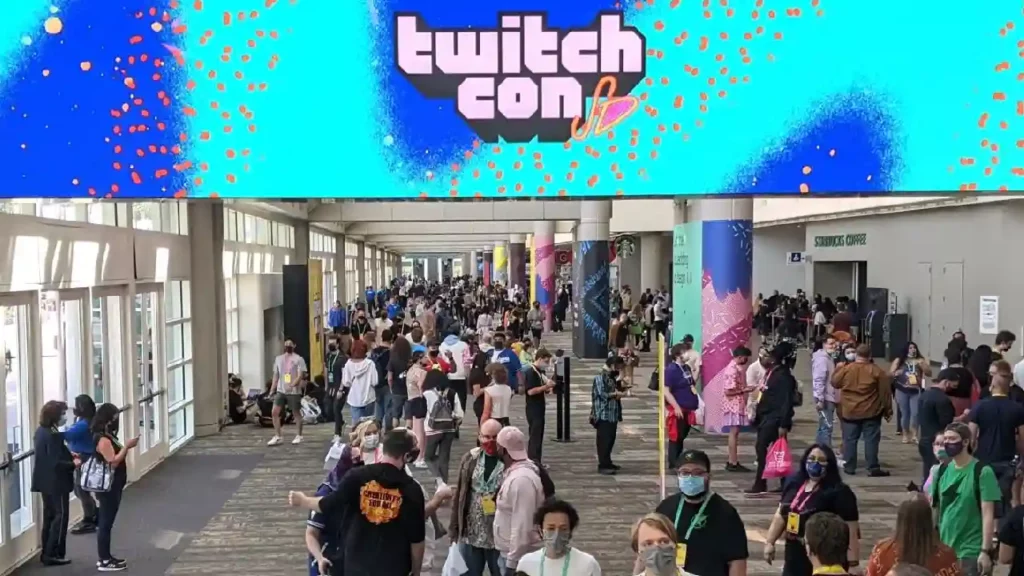
- Educational Content: Twitch offers guides, tutorials, and best practices to help streamers improve their content and grow their channels.
- Creator Dashboard: A comprehensive suite of analytics and management tools that allow streamers to track their performance, engage with their audience, and manage their streams efficiently.
These resources are invaluable for both novice and experienced streamers looking to navigate the complexities of live streaming and channel growth.
Comparative Analysis: YouTube vs Twitch Streaming Features and Benefits
Below is a comprehensive comparative analysis table that outlines the key features and benefits of YouTube and Twitch streaming, highlighting their similarities and differences to provide a clear overview for content creators and viewers.
| Feature/Benefit | YouTube Streaming | Twitch Streaming |
|---|---|---|
| Core Audience | Broad, diverse audience across various content types. | Primarily gamers and gaming enthusiasts, though expanding into other areas. |
| Content Variety | Wide range of content including vlogs, tutorials, music, gaming, and more. | Focused on gaming, live interactions, and creative content. |
| Monetization Options | Ad revenue, Super Chats, channel memberships, merchandise shelf. | Subscriptions, Bits (virtual tipping), ad revenue, affiliate sales. |
| Community Interaction | Live chats, premieres, polls, and comments section for VODs. | Live chat with emotes, raids, hosts, and channel points for increased engagement. |
| Content Flexibility | Live streams can be complemented with VODs, Shorts, and other video formats. | Stream content is typically live, with VODs available for a limited time. |
| Global Reach | Extremely high, with content and live streams accessible worldwide. | High, with a strong presence in North America and Europe, growing globally. |
| Platform Focus | Generalist platform with a strong emphasis on video content across categories. | Niche platform with a strong focus on live streaming, particularly in gaming. |
| User Interface | User-friendly, familiar to a broad audience due to YouTube’s popularity. | Tailored to live streaming and gaming audiences, with a focus on community engagement. |
| Stream Discovery | Algorithm-driven, based on user preferences, search history, and subscriptions. | Community-driven, with streams discovered through categories, tags, and recommendations. |
| Archiving Streams | Automatic archiving of live streams as videos on the channel. | Streams are archived temporarily, with options to create highlights or export to other platforms. |
| Support and Resources | Extensive creator academy, support forums, and YouTube Spaces for creators. | TwitchCon, creator camps, and extensive online support for streamers. |
| Analytics and Insights | Detailed analytics on viewer demographics, watch time, engagement, and more. | In-depth insights into viewer interactions, engagement metrics, and stream performance. |
| Integration with Ecosystem | Seamless integration with Google services and broader YouTube content ecosystem. | Integration with Amazon services and gaming ecosystems, including game drops and purchases. |
| Event Hosting | Supports a wide range of events including music concerts, educational streams, etc. | Strong in hosting gaming tournaments, charity streams, and community events. |
Whether you’re looking for broad reach and content diversity on YouTube or a tight-knit, gaming-focused community on Twitch, both platforms offer unique opportunities for engagement and growth.
Understanding YouTube and Twitch platforms’ Challenges and Limitations
Content creators must navigate platform-specific guidelines and restrictions, from copyright policy of YouTube and related issues to the gaming-focused content policy on Twitch. Each platform presents unique challenges, including algorithm changes on YouTube and discoverability issues on Twitch.
YouTube Streaming Challenges and Limitations
1. Content Discovery and Algorithm Dependence
- Algorithm Changes: YouTube’s algorithm is notoriously opaque and subject to frequent changes, impacting how content is discovered and prioritized.
- Content Saturation: The vast amount of content on YouTube can make it challenging for new streamers to stand out and gain visibility.
2. Monetization and Ad Policies
- Strict Monetization Rules: YouTube has stringent criteria for channel monetization, which can be a significant hurdle for new creators.
- Ad-Friendly Content: The platform’s emphasis on ad-friendly content can limit creative freedom, especially for topics that might be considered controversial or not advertiser-friendly.
3. Copyright Issues
- Content ID System: YouTube’s automated Content ID system can mistakenly flag content for copyright infringement, leading to demonetization or removal of videos, affecting live streams as well.
Twitch Streaming Challenges and Limitations
1. Platform Specificity and Audience Focus
- Gaming-Centric: Twitch’s strong association with gaming can make it challenging for non-gaming content creators to find an audience.
- Niche Audience: The platform’s focus on a specific audience segment can limit broader reach and appeal.
2. Discoverability and Saturation
- Discoverability: New streamers often struggle with discoverability due to the platform’s layout and the dominance of established streamers.
- Viewer Distribution: Viewership tends to be top-heavy, with the most popular streamers capturing the majority of viewers, making it challenging for smaller channels to grow.
3. Community Management
- Chat Moderation: Managing a live chat can be challenging, especially with larger audiences, requiring robust moderation to maintain a positive community environment.
- Troll and Harassment: Twitch streamers can be susceptible to trolling and harassment, necessitating strong community guidelines and moderation.
Common Challenges Across Both Platforms
1. Technical Barriers
- Streaming Quality: Ensuring high-quality, reliable streams requires significant technical setup, including strong internet connections and capable hardware.
- Platform Updates: Frequent updates and changes to the platforms can disrupt established workflows and require streamers to constantly adapt.
2. Mental Health and Burnout
- Consistency vs. Burnout: The pressure to stream consistently and engage with audiences can lead to burnout, particularly without proper balance and breaks.
- Online Harassment: Content creators on both platforms can face online harassment, impacting mental health and well-being.
3. Platform Policies and Guidelines
- Evolving Policies: Keeping up with changing platform policies and guidelines can be daunting, with violations potentially leading to demonetization or bans.
- Content Restrictions: Both platforms have content restrictions that can limit the scope of what creators can produce and share, impacting creative expression.
While YouTube and Twitch offer vast opportunities for content creators, navigating the challenges and limitations of these platforms requires resilience, adaptability, and a strategic approach to content creation and community engagement. Understanding these hurdles is the first step toward building a successful streaming presence, regardless of the chosen platform.
Comparing Future Trends and Predictions of YouTube vs Twitch Streaming
The streaming landscape is ever-evolving, with emerging technologies and shifting market dynamics shaping the future of platforms like YouTube and Twitch. Innovations in streaming quality, interactivity, and monetization models are expected to drive the industry forward.
Below is a comparative analysis table focusing on the anticipated future trends in YouTube and Twitch streaming, highlighting how each platform may evolve and what new directions they might take in response to technological advancements, changing viewer habits, and market dynamics.
| Future Trend/Aspect | YouTube Streaming | Twitch Streaming |
|---|---|---|
| Technological Innovations | Increased adoption of VR and AR to enhance interactive and immersive experiences. | Integration of more advanced interactive features like real-time game integration and augmented reality. |
| Content Diversity | Expansion beyond gaming to include more diverse content such as education, DIY, and virtual events. | Continued focus on gaming while expanding into non-gaming categories like music, talk shows, and lifestyle content. |
| Monetization Models | Evolution of current monetization options and potentially new models like micropayments for premium content or features. | Enhanced subscription models and innovative ways for viewers to support creators, such as through cryptocurrency or NFTs. |
| Audience Engagement | Enhanced live interaction tools such as more sophisticated chat features, real-time polling, and audience participation in streams. | Deeper community engagement through personalized experiences, loyalty programs, and advanced moderation tools to foster inclusive environments. |
| Global Expansion | Further localization and support for international creators and audiences, including more language options and regional content. | Increased focus on global markets with localized content and community building efforts to cater to diverse international audiences. |
| Content Discovery | Improved algorithms and AI to better match viewers with streams they’re interested in, enhancing personalization and discovery. | Enhanced discoverability features for new and smaller streamers, potentially through community-driven curation and recommendation systems. |
| Esports and Gaming | Greater investment in esports, live tournaments, and gaming events, potentially including exclusive broadcasting rights. | Strengthening of its position as the leading platform for esports and live gaming events with more exclusive partnerships and integrations. |
| Platform Integrations | More integrations with third-party tools and platforms for content creation, distribution, and analytics. | Expansion of Twitch Extensions and other tools that allow streamers to integrate a wide range of interactive and multimedia content into their streams. |
| Mobile Streaming | Enhanced features and support for mobile streaming, catering to the growing trend of mobile content creation and consumption. | Improvements in mobile streaming capabilities and user experience, acknowledging the significant portion of the audience that uses mobile devices. |
| Sustainability and Ethics | Increased focus on sustainable streaming practices and ethical guidelines to address digital well-being and content responsibility. | Implementation of more robust policies and community guidelines to promote positive, inclusive, and sustainable streaming environments. |
This table projects the potential directions YouTube and Twitch might take as they adapt to emerging trends and technologies. Both platforms are likely to evolve in response to user demands, technological advancements, and the competitive landscape of digital streaming, shaping the future of online entertainment and community engagement.
Case Studies: Successful Streamers
Examining the journeys of successful streamers on both platforms reveals insights into growth strategies, audience engagement, and monetization techniques, offering valuable lessons for aspiring content creators.
Case Study 1: Ludwig’s Twitch vs. YouTube Streaming Journey
Ludwig Ahgren’s transition from Twitch to YouTube serves as a compelling case study in the streaming world, illustrating the nuances of platform dynamics, audience migration, and content strategy adaptations. This case study delves into Ludwig’s journey, highlighting his strategic decisions, challenges, and outcomes associated with moving from Twitch to YouTube.

Twitch Beginnings: Building a Foundation
- Growth and Community Engagement: Ludwig initially rose to fame on Twitch, leveraging his charismatic personality and diverse content, which ranged from gaming to “Just Chatting” segments. His interactive, engaging approach with the audience laid the groundwork for a dedicated community.
- Innovative Content- The “Subathon”: A pivotal moment in Ludwig’s Twitch career was his “Subathon” event, where each subscription added time to his stream’s duration. This marathon stream, lasting over 30 days, broke records and significantly boosted his visibility and subscriber count.
- Challenges on Twitch: Despite his success, Ludwig faced challenges inherent to Twitch, including platform saturation, discoverability issues for new or smaller streamers, and limitations in content diversification outside gaming-centric streams.
Related Article: How to Plan a Subathon Successfully on Twitch or YouTube
Transition to YouTube Streaming: A New Chapter
- The Move to YouTube: In late 2021, Ludwig made a high-profile switch to YouTube Gaming, joining a wave of streamers exploring opportunities outside Twitch. This move was driven by a desire for broader content flexibility and a more favorable contract structure.
- Adapting to YouTube’s Ecosystem: Ludwig’s transition to YouTube involved adapting to a different content discovery algorithm, audience expectations, and streaming features. He leveraged YouTube’s strengths, such as better VOD integration and the potential for greater content diversity.
- Maintaining and Growing the Audience: One of Ludwig’s key challenges was maintaining his community and viewership during the transition. He employed strategies such as consistent scheduling, cross-platform promotion, and leveraging YouTube’s algorithm to recommend live content.
- Monetization and Content Strategy: On YouTube, Ludwig explored new monetization avenues, including channel memberships and expanded ad revenue opportunities. He diversified his content further, incorporating more varied formats that appealed to YouTube’s wider audience base.
Impact and Insights
- Audience Reception and Engagement: Ludwig’s community largely followed him to YouTube, demonstrating the loyalty of his fanbase and the growing acceptance of YouTube as a viable platform for live streaming.
- Content Diversity: The move allowed Ludwig to experiment with a wider range of content types, benefiting from YouTube’s vast audience and its algorithm’s ability to surface diverse content.
Platform Dynamics
- Ludwig’s journey underscores the importance of platform choice in a creator’s career. His successful transition highlighted YouTube’s growing appeal for live streamers seeking flexibility beyond gaming-centric content.
Future Implications
- Ludwig’s case is indicative of a broader trend where streamers are no longer bound to a single platform. The fluidity between platforms like Twitch and YouTube is reshaping the streaming landscape, offering creators more control over their content and careers.
Case Study 2: PewDiePie (Felix Kjellberg)’s Rise to Fame on YouTube
- Background: Starting as a gaming channel in 2010, PewDiePie quickly grew to become one of the most subscribed channels on YouTube, venturing beyond gaming into comedy, commentary, and vlogs.
- Growth Strategies: Consistency, original content, and a unique sense of humor helped Felix stand out. Engaging directly with his audience through comments and “Let’s Play” videos created a loyal fanbase.
- Monetization: Initially reliant on ad revenue, PewDiePie diversified with merchandise, sponsorships, and book sales. His ability to adapt content while maintaining his unique voice has been key to his sustained success.

Case Study 3: Ninja (Tyler Blevins)’s Niche Explosive Rise on Twitch
- Background: Ninja‘s journey on Twitch began with streaming Halo, but his rise to fame was propelled by Fortnite’s popularity. His engaging gameplay and energetic personality attracted millions of followers.
- Growth Strategies: High-level gameplay combined with a charismatic and relatable online persona helped Ninja grow. Strategic collaborations, including a stream with rapper Drake, significantly boosted his visibility.
- Monetization: Ninja capitalized on Twitch’s monetization options, including subscriptions, bits, and donations. His brand expanded into sponsorships, merchandise, and exclusive deals, illustrating the potential beyond platform-based earnings.
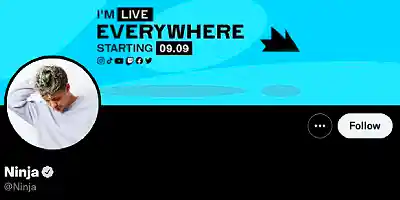
Key Takeaways for Aspiring Streamers
1. Maintain Streaming Consistency and Quality
- Ludwig, PewDiePie and Ninja maintained a consistent streaming and content creation schedule, ensuring regular engagement with their audience. Quality content that resonates with viewers is fundamental.
2. Do Active Engagement and Community Building
- Active engagement with their communities through comments, live chats, and social media helped build a loyal following. Creating a sense of belonging and appreciation for viewers fosters community loyalty.
3. Focus on Diversification and Adaptability
- Diversifying content and revenue streams, as well as adapting to new trends and platforms, played a crucial role in their sustained success. Flexibility in content creation and business strategies can help navigate the volatile online landscape.
4. Work on Personal Branding and Collaboration
- Developing a strong personal brand and leveraging collaborations with other creators and celebrities can significantly enhance visibility and growth. Networking within and outside the platform is crucial.
5. Make Effective Use of Platform Features
- Effectively utilizing platform-specific features, such as YouTube’s algorithm and Twitch’s community engagement tools, can aid in growing and maintaining an audience.
6. Keep Exploring and Evolving your Monetization Strategies
- Exploring various monetization avenues, including platform-specific options, sponsorships, and merchandise, can provide financial stability and independence.
YouTube vs Twitch Streaming: Top FAQs
What is the primary difference between YouTube and Twitch streaming?
The primary difference lies in their core focus and audience: YouTube offers a broader range of content and a wider audience, while Twitch is more niche, focusing primarily on gaming and live interactions.
Can you monetize your streams on both YouTube and Twitch?
Yes, both platforms offer monetization options, though they differ in structure. YouTube provides ad revenue, Super Chats, and memberships, while Twitch focuses on subscriptions, bits, and donations.
Is it better to start streaming on YouTube or Twitch?
The choice depends on the content type and target audience. YouTube is versatile and familiar, making it accessible for beginners, while Twitch offers a dedicated community for gaming and live content.
How important is community interaction on these platforms?
Community interaction is crucial on both platforms, enhancing the streaming experience and building loyal audiences. Twitch emphasizes this with its chat features and community-building tools, while YouTube also provides interactive options like live chat and premieres.
Can non-gaming content succeed on Twitch?
While Twitch is gaming-centric, there’s a growing space for non-gaming content under categories like “Just Chatting” and “Creative.” Success in these areas requires engaging content and active community interaction.
How do YouTube and Twitch handle content archives?
YouTube automatically archives live streams, integrating them into your video library. Twitch also archives streams, but they are only available for a limited time unless saved as highlights or converted into VODs.
Is it easier to grow on Twitch or YouTube?
Growing on Twitch can be more challenging due to its emphasis on real-time engagement, while YouTube has a broader audience but higher competition for content.
What is the difference between YouTube vs Twitch streaming money?
Monetization options on YouTube include ad revenue, channel memberships, and sponsored content, while Twitch offers subscriptions, bits, and donations for streamers. Twitch emphasizes real-time viewer engagement, while YouTube has a broader audience but may require effective promotion. Success on either platform depends on content quality and audience engagement.
In Closing: Choosing your Streaming Journey Companion Platform
In the digital streaming age, YouTube and Twitch have carved out significant niches in the streaming world, each offering unique pathways for content creators considering streaming as their career path.
Whether through the versatile content landscape of YouTube or the immersive community experience of Twitch, the opportunities for engagement, growth, and monetization are boundless.
As streaming continues to evolve, so too will the strategies for success on these platforms, guided by the ever-changing preferences of their diverse audiences. So, whichever platform you choose, go all out and make full use of the features and benefits each of them offer to grow your career.
Happy Streaming!
